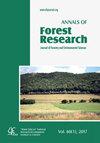灰狼(Canis lupus)重返中欧:文化景观未来管理的挑战和建议
IF 2.9
3区 农林科学
Q2 FORESTRY
引用次数: 8
摘要
灰狼实际上是从东部或南部种群移民到中欧,建立种群并成功繁殖。这一发展始于21世纪初,导致人口呈指数级增长,直到今天。本文从生态、社会经济和社会文化方面分析了灰狼(Canis lupus)对中欧的重新殖民,并提出了一个示范性管理概念的基本要点。直到今天,狼的管理,尤其是在德国、奥地利和瑞士,普遍遵循被动的“观望”策略。因此,对小型牲畜、牛和马的捕食正在迅速增加。尤其是农民和牧民呼吁采取更积极的方式来管理狼。中欧的穆弗洛恩种群(Ovis ammon musimon)在其自然范围内处于高度濒危状态,随着狼的出现,它们正在完全消失。狩猎野生有蹄类动物变得更加困难,而狼捕食的影响并没有显著减少吠叫和觅食对森林的破坏。通过放牧保护开阔景观来维持生物多样性可能会变得越来越困难。本文件表明,需要一个更积极的管理概念,该概念是在参与过程中发展起来的,在当地有区别,并结合不同的管理措施,如全面保护、可持续利用、预防疾病、群体保护措施和其他措施。本文章由计算机程序翻译,如有差异,请以英文原文为准。
Return of grey wolf (Canis lupus) to Central Europe: challenges and recommendations for future management in cultural landscapes
Grey wolf actually is immigrating Central Europe from eastern or southern populations, establishing packs and reproducing successfully. This development, starting in the beginning of the 2000s, led to an exponential population increase until today. The present paper analyzes re-colonization of Central Europe by Grey wolf (Canis lupus), considering ecological, socio-economical as well as socio-cultural aspects, and develops basic points for an exemplary management concept. Until today, wolf management especially in Germany, Austria and Switzerland, widely follows a passive “wait and see” strategy. Thus, predations of small livestock, cattle, and horses are quickly increasing. Especially farmers and herdsmen call for a more active way of wolf management. The Central European populations of mouflon (Ovis ammon musimon), being highly endangered in its natural range, are completely disappearing with the occurrence of wolf. Hunting of wild ungulates becomes more difficult whereas forest damages by barking and browsing are not significantly reduced by the influence of wolf predation. Maintaining biodiversity by preserving open landscapes by grazing might become more and more difficult. The present paper shows the need for a more active management concept, developed from a participatory process, locally differentiated and combining different management measures, as e.g. total protection, sustainable utilization, prevention of diseases, herd protection measures and others.
求助全文
通过发布文献求助,成功后即可免费获取论文全文。
去求助
来源期刊

Annals of Forest Research
FORESTRY-
CiteScore
2.20
自引率
11.10%
发文量
11
审稿时长
12 weeks
期刊介绍:
Annals of Forest Research is a semestrial open access journal, which publishes research articles, research notes and critical review papers, exclusively in English, on topics dealing with forestry and environmental sciences. The journal promotes high scientific level articles, by following international editorial conventions and by applying a peer-review selection process.
 求助内容:
求助内容: 应助结果提醒方式:
应助结果提醒方式:


